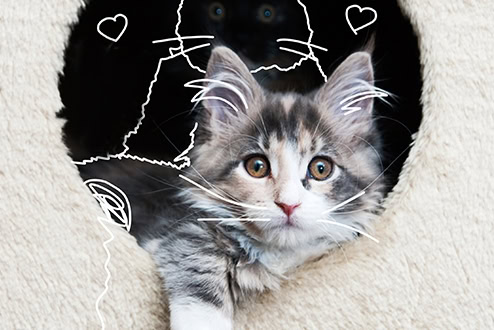How to keep your indoor cat purring and pampered
For a variety of reasons, many people wish to keep their feline friend as an indoor cat. As with humans, sometimes life indoors can become boring for indoor cats (and stressful) if there’s not enough to keep them interested and entertained.
Indoor cats may be prone to anxiety and weight gain, especially if they have previously been used to having outside access and are now an indoor only cat due to circumstances. They can also experience more stress by changes to their environment as they spend all of their time indoors.
Maintaining a healthy weight for indoor cats
Your indoor cat can easily become overweight as they may have less space to be active in. If you’re using the “free feeding” method of leaving their bowl out all day and topping it up when it starts to get empty, it’s tricky to get a real idea of how much your cat is eating. If your indoor cat is already overweight, this could be the culprit.

Discuss with your vet about trying specific indoor cat diets, which might be better in maintaining a healthy weight for your cat as they tend to have fewer calories and be lower in fat.
Keeping indoor cats active and entertained
For the most part, indoor cats rely much more on you to keep them active so it’s very important to spend time playing with them – ideally on a daily basis.
It’s also likely that you will be their main source of company too, especially if they are the only pet in the home. This makes it particularly key that you spend time with them when you can so they are less likely to feel bored and stressed by their indoor life.
Cat trees can also provide some climbing access and a different view of the world, which can mix things up for your cat.
Other tips for indoor cat living
Keeping their claws busy (like on a scratching post like this) can save your furniture from being shredded. You might find it useful to have more than one in different parts of the home so your cat can use them when the mood takes them. If you’re not convinced they will actually use a scratching post, catnip can be a useful incentive.
Litter trays can be another area of concern. If your cat isn’t going outside to the toilet, you will need to be particularly careful where you place their litter tray so that they are sure to use it.
A quiet place that will afford them a good degree of privacy is crucial (away from their food and drink area) and if you have more than one cat, it’s likely that they will be put off using their litter trays if they are too close together.
As always, it’s wise to have a cat insurance policy in place for your indoor cat for in the event of unexpected illness or injury.
You might also be interested in…
Get a quote in minutes…

Existing customers
Call now on 0808 164 7999
to discuss your policy with us.
Monday - Friday: 08:00 - 20:00 Saturday: 09:00 - 14:00





 Back
Back
